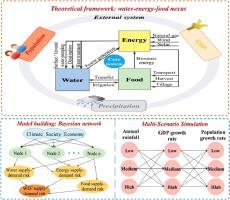Resources, Conservation and Recycling ( IF 11.2 ) Pub Date : 2021-07-15 , DOI: 10.1016/j.resconrec.2021.105799 Yong Wang , Yang Zhao , Yunyue Wang , Xuejiao Ma , He Bo , Jian Luo

|
The risks associated with water-energy-food (WEF) nexus can be determined by analyzing the three resources as a system and subsequently measuring the probability of resource shortages in this system under the influences of external factors such as climate, economy, and society. In this study, a Bayesian network (BN) model was used to construct the supply-demand risk assessment framework, identify the risk factors during different periods in the Beijing-Tianjin-Hebei (BTH) region, and simulate the probability of supply-demand risk under different scenarios. The results showed that (1) the WEF supply-demand risk in the BTH region originated from not only core system factors, but also from external system factors. (2) The factors affecting the WEF supply-demand risk varied significantly over time. In the tortuous development stage (1989–1998), industrial and agricultural water use intensity were highly important. In the rapid development stage (1999–2008), the population growth rate became the main factor. In the coordinated development stage (2009–2018), the water and food supply-demand risks became increasingly important. (3) In scenarios where representative climate-economy-society factors (rainfall, gross domestic product, and population) were in high-high-high, medium-high-high, low-medium-high, and low-high-high, respectively, the probability of WEF supply-demand risk increased significantly. This probability was effectively reduced in medium-low-low, medium-medium-low, and medium-high-low scenarios. Using BN to study the WEF supply-demand risk allows for an intuitive understanding of the interaction mechanisms among variables in the WEF nexus. This approach also enables the design of more realistic scenarios, thus providing a reference for the formulation of early risk warning mechanisms.
中文翻译:

区域水-能源-粮食关系供需风险评估与多情景模拟——以京津冀地区为例
与水-能源-食品(WEF)关系相关的风险可以通过将三种资源作为一个系统进行分析,然后测量该系统在气候、经济和社会等外部因素影响下资源短缺的概率来确定。本研究利用贝叶斯网络(BN)模型构建供需风险评估框架,识别京津冀地区不同时期的风险因素,模拟供需概率不同场景下的风险。结果表明:(1)京津冀地区WEF供需风险不仅源于核心系统因素,也源于外部系统因素。(2)影响世界经济论坛供需风险的因素随时间变化显着。在曲折发展阶段(1989-1998),工业和农业用水强度非常重要。在快速发展阶段(1999-2008),人口增长率成为主要因素。在协调发展阶段(2009-2018年),水和粮食供需风险日益凸显。(3) 在代表性气候-经济-社会因子(降雨量、国内生产总值和人口)处于高-高-高、中-高-高、低-中-高、低-高-高的情景中,分别是,世界经济论坛供需风险的概率显着增加。这个概率在中低低、中中低、中高低的场景中得到了有效的降低。使用 BN 研究 WEF 供需风险,可以直观地了解 WEF 关系中变量之间的相互作用机制。











































 京公网安备 11010802027423号
京公网安备 11010802027423号